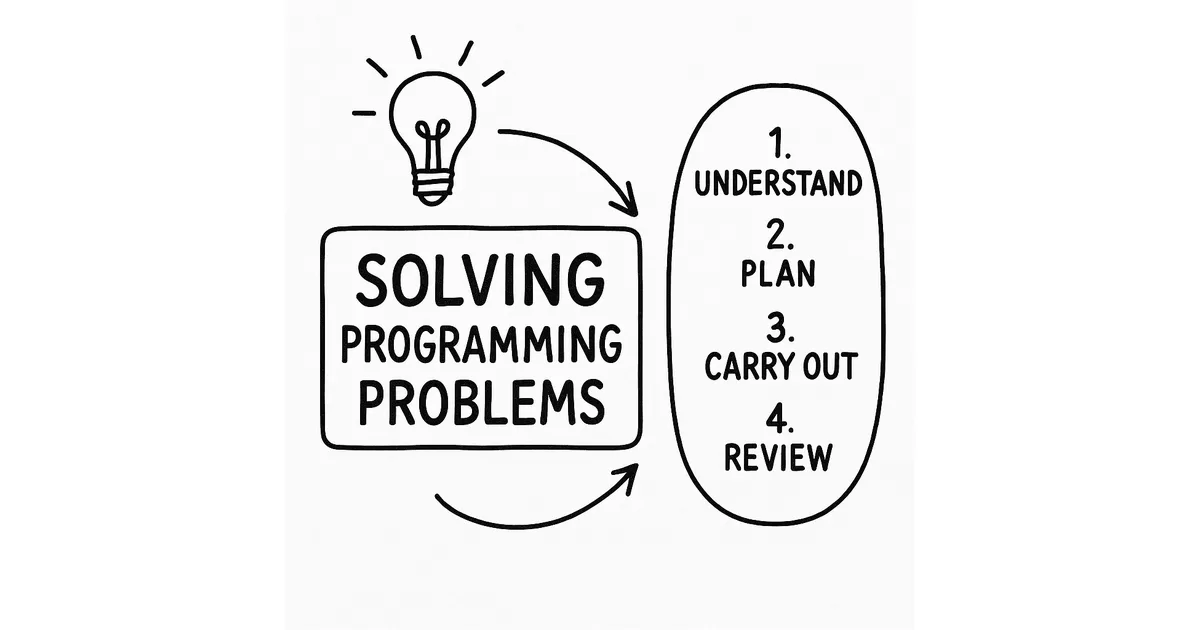If I had to summarize a programmers’ job in a few words, I would say we are ‘problem solvers’. However, it’s not that simple. Some problems are easy, some are hard, and in both cases, a specific set of skills is required.
When approaching programming problems, there’s a skill that is (or should be) always present: the capacity of abstraction. Dijkstra classifies this as the most vital activity of a competent programmer. He mentions abstraction not as a vague term but as a tool for handling complexity.
While I’m not well-versed to teach or explain abstraction without being too abstract I’d like to point out that mathematicians are pretty good at it. Observe some of them and how they solved some classic problems.
It’s interesting to see that they have a methodology. They are certain about the data they have, what they are looking for, and are especially very good at recognizing patterns (knowing where to do a clever substitution or to apply a theorem).
I humbly think a good way to improve your abstraction capability is to mimic this behavior. For that, you need a system
for solving any programming problem. Let’s construct one.
A Problem To Solve
Giving you a list is not ideal. It’s much better to see the system working while applying it to a problem. Let’s get a simple problem to solve.
The problem is :
You’re a programmer working on a parking system (implemented using Node.js and PostgreSQL). In the current implementation, users can schedule reservations, providing a start and an end date. Time is not considered since all dates should be counted as full days.
Your job now is to add the parking lot restriction since the park has only 5000 spots and the application should not overbook.
Have A Plan
The easier way to tackle a problem is to follow a plan. A plan with all steps defined gives you a direction and allows you to validate each step and, if needed, change the course; all under your control.
The hard part is to come up with a plan. That’s where many of us, software developers, fail.
Borrowing principles from the How To Solve It book, by George Polya, we have four things to do when solving a problem: understand the problem, devise the plan, carry out the plan, and look back.
While it’s a book about solving math problems, I think it works, with some changes, pretty well for software problems – I have been doing similar things in my contributions to the Node.js codebase.
Understanding The Problem
The first thing is to understand the problem. It seems obvious, but indeed it’s not. Sometimes you are too mechanical when analyzing a problem and just assume that you understood. It’s a bad move. You can trust your intuition, but you have to confirm.
To get a full understanding, ask yourself the right questions: what am I trying to find?, what do I have?, and what are the conditions/restrictions?
During this phase, you can also introduce any notation that you think will be useful.
Take the proposed problem. To avoid overbooking, it’s necessary to check the reservation that’s being scheduled against the already existing reservations that might overlap.
- what we have:
reservationthat is attempted to be scheduled. Areservationhasstart_atandend_atfields, both beingDate;reservationListis the list of already existing reservations to matchreservationagainst.
- restrictions:
- dates occupy the full day;
- the parking spots are limited to 5000.
- Node.js and PostgreSQL
- what we need to find: an algorithm that takes the
reservationin and determines if it can be scheduled or not;
The introduced notation of reservation and reservationList makes it a little bit easier to understand what’s going on. With this, you have a better understanding of what needs to be done.
Devising A Plan
Once you’ve reasoned about what needs to be done, it’s time to plan how you’re going to do this. For that, you can:
- observe the multiple parts of the problem, check the data and restrictions again;
- pull from your memory any other problem that looks similar;
- try to restate the original problem to make it simpler;
- drop/relax some conditions/restrictions so get sense of what subproblems are involved.
Analyzing problems from various perspectives allows you to streamline their complexity, making it fit in your brain with less effort.
After thinking a little bit about this problem and its conditions, I could restate it, already using the introduced notation in the last step, to:
Your task is to write a function that takes the
reservationListandreservation, finds the overlapping days, and checks if all of them have less than 5000 reservations. If all days in that period have less than 5000,reservationcan be scheduled.
To simplify the plan and its execution, let’s relax the PostgreSQL restriction and assume that we’re working with data in memory.
Our plan is then:
- Take the
resevationandreservationListand find the overlapping days; - Compute how many reservations exist for each day in the overlapping;
- Determine if the
reservationcan be scheduled;
For that, we’re going to use the reservation object as:
type Reservation = {
start_at: Date;
end_at: Date;
};Carrying Out The Plan
Our plan is simple because we have a small problem. What we do now is to walk through each step and ensure all of them are correct.
Step 1 – Find Overlapping Days
Finding overlaps is an already solved problem, and we can leverage the solution.
type Tuple = [Date, Date];
type OverlappingDates = Tuple[];
const getOverlapping = (reservationList: Reservation[], reservation: Reservation): OverlappingDates => {
const overlappingTuples = [];
for(const r of reservationList) {
const hasOverlapping = r.start_at <= reservation.end_at && r.end_at >= reservation.start_at;
if (!hasOverlapping) continue;
overlappingTuples.push([r.start_at, r.end_at]);
}
return overlappingTuples;
};NOTE: The code here will be imperative to make it as clear as possible for anybody.
After each step, you prove this step was executed correctly. Mathematicians prove them using math tricks, and we do that by writing tests.
Ensuring Step 1 Is Correct
Let’s write a couple of tests to ensure everything is working as expected.
import assert from 'node:assert';
const reservationList = [
{ start_at: new Date('2025-08-01'), end_at: new Date('2025-08-03') },
{ start_at: new Date('2025-08-01'), end_at: new Date('2025-08-02') },
{ start_at: new Date('2025-08-03'), end_at: new Date('2025-08-04') },
{ start_at: new Date('2025-08-05'), end_at: new Date('2025-08-07') },
];
const overlapping1 = getOverlapping(reservationList, {
start_at: new Date('2025-08-01'),
end_at: new Date('2025-08-03')
});
assert.deepStrictEqual(overlapping1, [
[new Date('2025-08-01'), new Date('2025-08-03')],
[new Date('2025-08-01'), new Date('2025-08-02')],
[new Date('2025-08-03'), new Date('2025-08-04')]
]);
const overlapping2 = getOverlapping(reservationList, {
start_at: new Date('2025-08-08'),
end_at: new Date('2025-08-10')
});
assert.deepStrictEqual(overlapping2, []); // there is no date overlapping the period from Aug 08 to Aug 10Pretty simple. Notice that all periods used are already normalized, defining only the date without time. That’s something you have to do in your application.
Step 2 – Compute How Many Reservations Exist Per Day
Such a function would give us a list of reservations that overlap with the one I’m trying to schedule. The third step in our plan asks us to check how many reservations exist per day.
const addDay = (original: Date) => {
const s = new Date(original);
s.setTime(s.getTime() + 24 * 60 * 60 * 1000);
return s;
};
const getReservationsCountPerDate = (overlappingDates: OverlappingDates) => {
const group = {};
for (const [start_at, end_at] of overlappingDates) {
let s = start_at;
while (s <= end_at) {
const k = s.toISOString().split('T')[0];
if (s >= start_at && s <= end_at) {
if (!group[k]) group[k] = 0;
group[k] += 1;
}
s = addDay(s);
}
}
return group;
};Remember to prove this step is correct with tests.
Step 3 – Determine Whether reservation Can Be Scheduled
From the two steps, you already have everything grouped per day. Now is the time to check if all the overlapping days are free.
const canSchedule = (maxSpots, reservationList, reservation) => {
const overlappingDates = getOverlapping(reservationList, reservation);
const totalReservationsByDate = getReservationsCountPerDate(overlappingDates);
return Object.values(totalReservationsByDate).every(n => n < maxSpots);
};Again… ensure it’s correct.
Looking Back
The job is not done yet. At this moment, you must look back at the whole plan and confirm whether you found what you were looking for, if all the requirements are fulfilled and if there are ways to simplify the solution.
A simplification can be done in step 2, for instance. When grouping, it takes the overlapping periods, even though some dates do not overlap at all. Here’s an example to illustrate.:
Suppose the reservationList contains a sample that is from Aug 01 to Aug 10. When trying to schedule a reservation from Aug 09 to Aug 10, there’s no need to count reservationList samples from Aug 01 to Aug 08.
Restating: the reservationList sample overlaps, but not necessarily all its days.
Another thing to think about is what happens if there’s a single spot left and two clients try to schedule it concurrently. Does the solution you came up with handle this? If not, what can be done? It’s a subproblem; you can apply this same system again and solve it.
Make This Real
As we relaxed the database requirements, we had a plan for a subproblem. At this moment, we can look back and bring that restriction back. For this problem specifically, it shouldn’t be that overwhelming to get it translated to SQL.
Tip: You can have a query to collect the overlapping tuples and continue with steps 2 and 3, or you can go beyond and have a single query taking care of the first two pieces of the plan.
Conclusion
To work on this system demands thinking, which can be hard, but as long as you continue doing it, repeating this behavior, you will get better at every single phase of the problem resolution.
It will improve your capacity of analysis and abstraction, enabling you to solve any programming problem.
We want to work with you. Check out our Services page!




